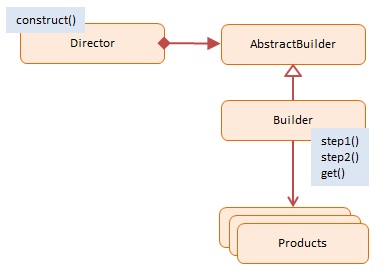Separate the construction of a complex object from its representation so that the same construction process can create different representations.
| Usage in JavaScript: |
|
low |
The Builder pattern allows a client to construct a complex object by specifying the type and content only. Construction details are hidden from the client entirely.
The most common motivation for using Builder is to simplify client code that creates complex objects. The client can still direct the steps taken by the Builder without knowing how the actual work is accomplished. Builders frequently encapsulate construction of Composite objects (another GoF design pattern) because the procedures involved are often repetitive and complex.
Usually it is the last step that returns the newly created object which makes it easy for a Builder to participate in fluent interfaces in which multiple method calls, separated by dot operators, are chained together (note: fluent interfaces are implementation of the Chaining Pattern as presented in the Modern patterns section).

The AbstractBuilder is not used because JavaScript does not support abstract classes. However, the different Builders must implement the same multistep interface for the Director to be able to step through the assembly process
The JavaScript code has a Shop (the Director) and two builder objects: CarBuilder and TruckBuilder. The Shop's construct method accepts a Builder instance which it then takes through a series of assembly steps: step1 and step2. The Builder's get method returns the newly assembled products (Car objects and Truck objects).
The client has control over the actual object construction process by offering different builders to the Shop.
The log function is a helper which collects and displays results.
function Shop() {
this.construct = function(builder) {
builder.step1();
builder.step2();
return builder.get();
}
}
function CarBuilder() {
this.car = null;
this.step1 = function() {
this.car = new Car();
};
this.step2 = function() {
this.car.addParts();
};
this.get = function() {
return this.car;
};
}
function TruckBuilder() {
this.truck = null;
this.step1 = function() {
this.truck = new Truck();
};
this.step2 = function() {
this.truck.addParts();
};
this.get = function() {
return this.truck;
};
}
function Car() {
this.doors = 0;
this.addParts = function() {
this.doors = 4;
};
this.say = function() {
log.add("I am a " + this.doors + "-door car");
};
}
function Truck() {
this.doors = 0;
this.addParts = function() {
this.doors = 2;
};
this.say = function() {
log.add("I am a " + this.doors + "-door truck");
};
}
// log helper
var log = (function () {
var log = "";
return {
add: function (msg) { log += msg + "\n"; },
show: function () { alert(log); log = ""; }
}
})();
function run() {
var shop = new Shop();
var carBuilder = new CarBuilder();
var truckBuilder = new TruckBuilder();
var car = shop.construct(carBuilder);
var truck = shop.construct(truckBuilder);
car.say();
truck.say();
log.show();
}
Run
The Namespace pattern is applied to keep the code out of the global namespace. Our namespace is named Patterns.Classic. A Revealing Module named Builder holds all of Builder's functions. Only the Shop, CarBuilder, and TruckBuilder are exposed (revealed), whereas the Car and Truck constructor functions are kept private inside the module.
The Patterns object contains the namespace function which constructs namespaces non-destructively, that is, if a name already exists it won't overwrite it.
The log function is a helper which collects and displays results.
var Patterns = {
namespace: function (name) {
var parts = name.split(".");
var ns = this;
for (var i = 0, len = parts.length; i < len; i++) {
ns[parts[i]] = ns[parts[i]] || {};
ns = ns[parts[i]];
}
return ns;
}
};
Patterns.namespace("Classic").Builder = (function () {
var Car = function () {
this.doors = 0;
this.addParts = function () {
this.doors = 4;
};
this.say = function () {
log.add("I am a " + this.doors + "-door car");
};
};
var Truck = function () {
this.doors = 0;
this.addParts = function () {
this.doors = 2;
};
this.say = function () {
log.add("I am a " + this.doors + "-door truck");
};
};
var Shop = function () {
this.construct = function (builder) {
builder.step1();
builder.step2();
return builder.get();
}
};
var CarBuilder = function () {
this.car = null;
this.step1 = function () {
this.car = new Car();
};
this.step2 = function () {
this.car.addParts();
};
this.get = function () {
return this.car;
}
};
var TruckBuilder = function () {
this.truck = null;
this.step1 = function () {
this.truck = new Truck();
};
this.step2 = function () {
this.truck.addParts();
};
this.get = function () {
return this.truck;
};
};
return {
Shop: Shop,
CarBuilder: CarBuilder,
TruckBuilder: TruckBuilder
};
})();
function run() {
var builder = Patterns.Classic.Builder;
var carBuilder = new builder.CarBuilder();
var truckBuilder = new builder.TruckBuilder();
var shop = new builder.Shop();
var car = shop.construct(carBuilder);
var truck = shop.construct(truckBuilder);
car.say();
truck.say();
log.show();
}
Run